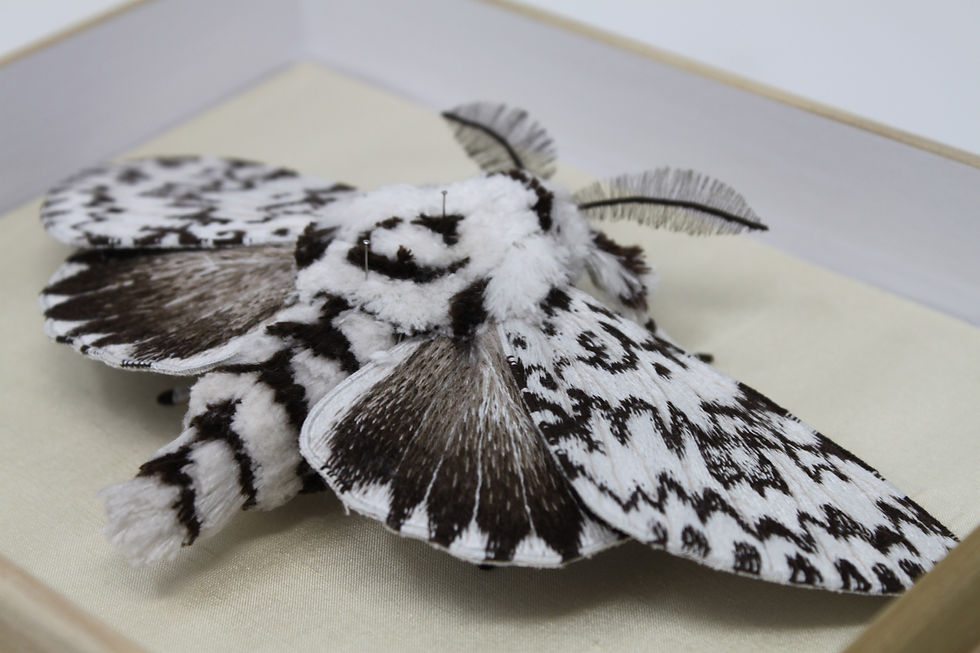Butterflies Revisited 2 - Embroidering Autism
- Tzipporah Johnston

- Oct 9, 2022
- 3 min read
Over the next month, I'm going to be writing a bit about the pieces I currently have on show at the Nature/Nurture exhibition at the Leyden Gallery in London. In this second post, I'm discussing the embroidered butterflies.

Last week I wrote a bit about how I started making butterflies, which were my first major textile project, as a response to the Natural History Museum/Pitt Rivers Museum in Oxford and the Victorian collecting mania that they showcase. I also mentioned that they formed a starting point for my installation, the Museum of Monotropism, and that I very much see them as being about autism, as well as about butterflies.
Left: The Museum of Monotropism in it's earliest iteration, in my friend Fi Bailey's sitting room, August 2019. Centre: The Lepidoptera Wall at the second iteration of the Museum, at Custom Lane Gallery in November 2021. Right: a view of the Museum set in the wider exhibtion space, Custom Lane Gallery, November 2021.
I was and still am very interested in how to make work about autism in a new and affirming way, without the usual focus on distress, stigma, or deficit. My life is not tragic, but a lot of the art about autism – at least the kind of art the wider public wants to consume – is. This is sadly true even within disability arts. Work by autistic artists is still pushed to conform to an "outsider art" stereotype, and some curators, commissioners and collectors still have very stigmatising attitudes. Last year, I attended an artist discussion event held by a major disability arts curator, where 3 artists were invited to talk about their practice and make new connections. The first artist to speak created art about the burden of having autistic children, describing the "daily grief" of raising autistic children. She said she used discarded pieces of metal because autistic people are "discarded people". The other artist sympathised, calling it a "living loss". When I finally regained the power of speech, I asked how her (teenaged) children feel about her making this work. She assured me that they like it, because the "natural self-centredness of autism" meant they just enjoyed being the centre of attention, and weren't able to reflect on the wider implications of the work. The curator, facilitating the meeting, said nothing. I left feeling horrible.
There is something debilitating about existing in a world that views you as fundamentally broken, a defective copy of a 'normal' person. Where the media you consume presents you as merely a one-dimensional collection of stereotypes and distress, a burden and disappointment to those around you. I wanted to share autistic experience in a more positive and more holistic way.
It was at this point that I was introduced to the idea of monotropism – the idea that a defining characteristic of autism is singularity of focus. Not only did it ring true with my experiences, it also offered a conceptual framework for autism that implied difference rather than deficit. Our tendency to hyperfocus, our intense special interests, and our desire to immerse ourselves in them as much as possible are often pathologized, but they needn’t be. In our hyperfocus we experience a sense of flow, peace and wellbeing.
I think part of what draws me places like the Pitt Rivers or Natural History Museum is a recognition of mental kinship. There's something monotropic about their creators' single-minded pursuit of a subject, whether it's butterflies or folk magic. In pursuing their passions, they created a world of beauty and wonder.
My early works leaned unashamedly into my hyperfocus, depicting my special interests – such as butterflies - in minute detail. It’s a portrait of the butterflies, but it’s also a portrait of my brain. It’s about the way we notice the world. It’s an invitation for you to notice too.
Some individually/small group mounted specimens. Left: Brimstone Butterfly. Centre: Adonis Blue and Small Heath Butterflies. Right: Red Admiral Butterfly. All finished 2019.















Comments